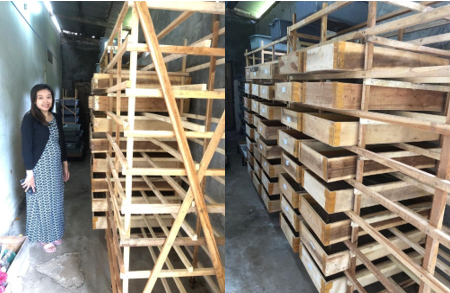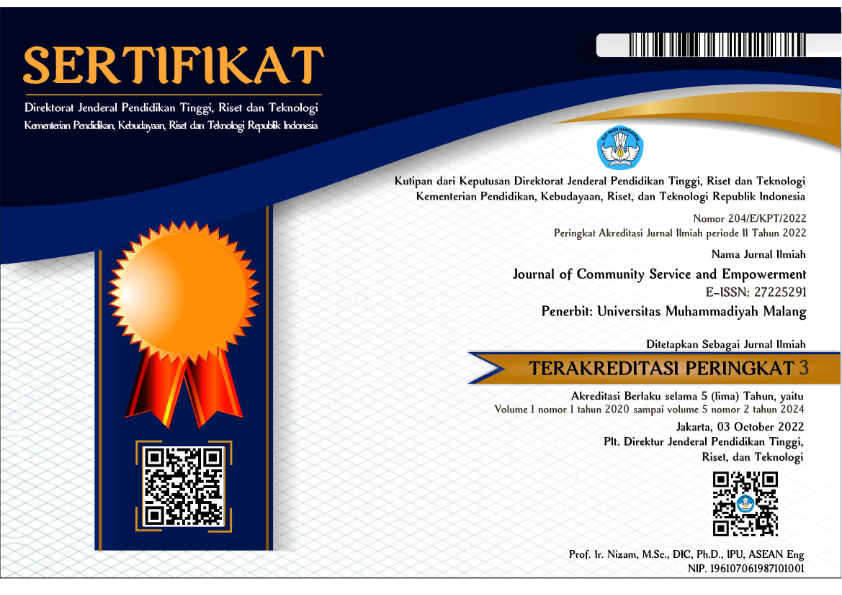Superworm (Zophobas morio) breeding for papaya stem waste management
DOI:
https://doi.org/10.22219/jcse.v4i2.26464Keywords:
superworm, breeding, feed, papaya stem, waste managementAbstract
Boyolangu District is a famous papaya-producing area and the largest in Tulungagung Regency. The local papaya farming community is active in farming. They succeeded in producing approximately 10 tons of papaya in 2020. This number has decreased by more than half from the previous year in 2019. This is inseparable from the impact of the COVID-19 pandemic. In addition, the community complaint about a large amount of papaya stem waste after harvest. Waste management is a separate problem for farmers. Not to mention the added problem of the low price of papaya per kilogram. Therefore, a community service program aims to overcome the target community's problems with superworm (Zophobas morio) breeding education and training. The activity conducted by the team of the Faculty of Agriculture, University of Kadiri empowering the papaya farming community in Boyolangu District, Tulungagung Regency to manage papaya stem waste as an alternative feed for superworm breeding. Farmers were invited to breed superworm as their additional income and improve the standard of living of the family. This activity mainly focused on the introduction and training of superworm breeding. The activity was beneficial for the social, economic, and environmental life of the target community.
Downloads
References
BPS Provinsi Jawa Timur. (2021). Luas panen tanaman sayuran dan buah-buahan semusim menurut kabupaten/kota dan jenis tanaman di Provinsi Jawa Timur (ha), 2019 dan 2020. https://jatim.bps.go.id/statictable/2021/09/06/2240/luas-panen-tanaman-sayuran-dan-buah-buahan-semusim-menurut-kabupaten-kota-dan-jenis-tanaman-di-provinsi-jawa-timur-ha-2019-dan-2020.html
Cacchiarelli, C., Fratini, F., Puccini, M., Vitolo, S., Paci, G., & Mancini, S. (2022). Effects of different blanching treatments on colour and microbiological profile of Tenebrio molitor and Zophobas morio larvae. Lwt, 157(November 2021), 113112. https://doi.org/10.1016/j.lwt.2022.113112
Handayani, K., Putri, A. E., & Martha, R. D. (2020). Uji aktivitas antibakteri fraksi batang pepaya (Carica Papaya Linn.) teRHADAP BAKTERI Staphylococcus Aureus. JOPS (Journal Of Pharmacy and Science), 4(1), 21–30. https://doi.org/10.36341/jops.v4i1.1446
Harsanyi, E., Juhasw, C., Kovacs, E., Huzsvai, L., Pinter, R., Fekete, G., Varga, Z. I., Aleksza, L., & Gyuricza, C. (2020). Evaluation of organic wastes as substrates for rearing zophobas morio, tenebrio molitor, and acheta domesticus larvae as alternative feed supplements. Insects, 11(604), 1–17. https://doi.org/10.3390/insects11090604
Hopley, D. (2016). The evaluation of the potential of Tenebrio molitor, Zophobas morio, Naophoeta cinerea, Blaptica dubia, Gromphardhina portentosa, Periplaneta americana, Blatta lateralis, Oxyhalao duesta and Hermetia illucens for use in poultry feeds. Stellenbosch University. Thesis (MSc AgriScience), March, 90. https://scholar.sun.ac.za/handle/10019.1/98583
Jiang, S., Su, T., Zhao, J., & Wang, Z. (2021). Biodegradation of polystyrene by tenebrio molitor, galleria mellonella, and zophobas atratus larvae and comparison of their degradation effects. Polymers, 13(20). https://doi.org/10.3390/polym13203539
Junaidi, J., Lisanty, N., Turohmah, N. U., & Hadiyanti, N. (2022). Pelatihan pembuatan pupuk organik cair dengan bantuan lalat hitam (Black Soldier Fly) di Desa Sumberjo Kabupaten Nganjuk. JATI EMAS (Jurnal Aplikasi Teknik Dan Pengabdian Masyarakat), 6(2), 11–16. https://doi.org/10.36339/je.v6i2.590.
Kim, S. Y., Kim, H. G., Song, S. H., & Kim, N. J. (2015). Developmental characteristics of Zophobas atratus (Coleoptera: Tenebrionidae) larvae in different instars. International Journal of Industrial Entomology, 30(2), 45–49. https://doi.org/10.7852/ijie.2015.30.2.45
Kosewska, O., Porzuc, B., & Przemieniekci, S. W. (2022). Multifaceted application of superworm (zophobas morio f.) in the zero-waste circular economy approach. Proceedings of the XIII International Scientific Agricultural Symposium “Agrosym 2022,” 13, 881–888. https://doi.org/10.1111/j.1744-7348.2008.00272.x
Kuan, Z. J., Chan, B. K. N., & Gan, S. K. E. (2022). Worming the circular economy for biowaste and plastics: Hermetia illucens, Tenebrio molitor, and Zophobas morio. Sustainability (Switzerland), 14(3), 1–13. https://doi.org/10.3390/su14031594
Li, L., Stasiak, M., Li, L., Xie, B., Fu, Y., Gidzinski, D., Dixon, M., & Liu, H. (2016). Rearing tenebrio molitor in BLSS: Dietary fiber affects larval growth, development, and respiration characteristics. Acta Astronautica, 118, 130–136. https://doi.org/https://doi.org/10.1016/j.actaastro.2015.10.003
Lisanty, N. (2021). Inovasi sebagai kunci untuk tetap tumbuh pascapandemi. In Mewujudkan Indonesia Tangguh, Indonesia Tumbuh dengan Inovasi di Era Pandemi (p. 104). UNIK Press. https://books.google.co.id/books?id=QBZ2EAAAQBAJ&newbks=0&dq=indonesia+tangguh&hl=id&source=gbs_navlinks_s
Lisanty, N., Andajani, W., Pamudjiati, A. D., & Artini, W. (2021). Regional overview of food security from two dimensions: Availability and access to food, East Java Province. Journal of Physics: Conference Series, 1899(1), 4–10. https://doi.org/10.1088/1742-6596/1899/1/012067
Lisanty, N., Hadiyanti, N., Prayitno, R. A., & Chairul Huda, R. (2021). Pengolahan limbah dapur menjadi pupuk organik cair (POC) untuk aplikasi pertanian lahan pekarangan di Kecamatan Pace dan Ngronggot Kabupaten Nganjuk. Jatimas : Jurnal Pertanian Dan Pengabdian Masyarakat, 1(2), 121–133. https://ojs.unik-kediri.ac.id/index.php/jatimas/article/view/2090
Lisanty, N., & Junaidi, J. (2021). Produksi pupuk organik cair (POC) dengan memanfaatkan mikro organisme lokal (MOL) di Desa Jegreg Kabupaten Nganjuk. JATIMAS: Jurnal Pertanian dan Pengabdian Masyarakat, 1(1), 1–10. https://ojs.unik-kediri.ac.id/index.php/jatimas/article/download/1668/1526
Luo, L., Wang, Y., Guo, H., Yang, Y., Qi, N., Zhao, X., Gao, S., & Zhou, A. (2021). Biodegradation of foam plastics by Zophobas atratus larvae (Coleoptera: Tenebrionidae) associated with changes of gut digestive enzymes activities and microbiome. Chemosphere, 282, 131006. https://doi.org/https://doi.org/10.1016/j.chemosphere.2021.131006
Mariyono, M., Lisanty, N., & Gunariyati, Y. N. (2022). Penggunaan barang bekas sebagai alternatif wadah tanaman di Desa Jati Kabupaten Kediri. Bubungan Tinggi: Jurnal Pengabdian Masyarakat, 4(3), 772. https://doi.org/10.20527/btjpm.v4i3.5674
Nirmala, A., Hardiatma, A., Nurhikmah, N., & Saleh, L. (2022). Penggunaan batang pepaya dalam pengendalian penyakit infeksi bakteri pada pembesaran ikan Nila. Prosiding Seminar Nasional Politeknik Pertanian Negeri Pangkajene Kepulauan, 3(September), 154–162. https://doi.org/10.51978/proppnp.v3i1.259
Porzuc, B., Kosewska, O., & Przemieniekci, S. W. (2022). Fertilisation potential of digestate obtained from Zophobas Morio Frass. Proceedings of the XIII International Scientific Agricultural Symposium “Agrosym 2022,” 13, 956–1101. https://doi.org/10.1038/180996b0
Probojati, R. T., Hadiyanti, N., Alfatin, M., Zulkarnain, A., & Lisanty, N. (2022). Pelatihan pemanfaatan limbah botol plastik sebagai wadah media tanam di Desa Mojoroto Kelurahan Mojoroto Kota Kediri. J-Abdipamas, 6(1), 27–32. http://dx.doi.org/10.30734/j-abdipamas.v6i1.2354
Rohman, F., Saefulhadjar, D., & Sinaga, S. (2022). Pengaruh pemberian media nutrisi yang berbeda terhadap pertambahan bobot badan, konversi pakan, dan daya hidup ulat jerman (Zophobas morio). Jurnal Nutrisi Ternak Tropis Dan Ilmu Pakan, 4(2), 53–58. https://doi.org/10.24198/jnttip.v4i2.40519
Susilawati, S., Falefi, R., & Purwoko, A. (2020). Impact of COVID-19’s pandemic on the economy of Indonesia. Budapest International Research and Critics Institute (BIRCI-Journal): Humanities and Social Sciences, 3(2), 1147–1156. https://doi.org/10.33258/birci.v3i2.954
van Broekhoven, S., Oonincx, D. G. A. B., van Huis, A., & van Loon, J. J. A. (2015). Growth performance and feed conversion efficiency of three edible mealworm species (Coleoptera: Tenebrionidae) on diets composed of organic by-products. Journal of Insect Physiology, 73, 1–10. https://doi.org/https://doi.org/10.1016/j.jinsphys.2014.12.005
Watung, E. J., Maarisit, W., Sambou, C. N., & Kanter, J. W. (2020). Uji efektivitas sediaan gel ekstrak batang pepaya (Carica papaya L.) sebagai penyembuh luka sayat pada tikus putih (Rattus novergicus). The Tropical Journal of Biopharmaceutical, 3(2), 1–7. https://doi.org/10.55724/j.biofar.trop.v3i2.278
Yang, Y., Wang, J., & Xia, M. (2020). Biodegradation and mineralization of polystyrene by plastic-eating superworms Zophobas atratus. Science of The Total Environment, 708, 135233. https://doi.org/https://doi.org/10.1016/j.scitotenv.2019.135233
Zaelor, J., & Kitthawee, S. (2018). Growth response to population density in larval stage of darkling beetles (Coleoptera; Tenebrionidae) Tenebrio molitor and Zophobas atratus. Agriculture and Natural Resources, 52(6), 603–606. https://doi.org/10.1016/j.anres.2018.11.004
Zielińska, E., Zieliński, D., Jakubczyk, A., Karaś, M., Pankiewicz, U., Flasz, B., Dziewięcka, M., & Lewicki, S. (2021). The impact of polystyrene consumption by edible insects Tenebrio molitor and Zophobas morio on their nutritional value, cytotoxicity, and oxidative stress parameters. Food Chemistry, 345, 128846. https://doi.org/https://doi.org/10.1016/j.foodchem.2020.128846
Żołnierczyk, A. K., & Szumny, A. (2021). Sensory and chemical characteristic of two insect species: Tenebrio molitor and zophobas morio larvae affected by roasting processes. Molecules, 26(9). https://doi.org/10.3390/molecules26092697

Downloads
Published
How to Cite
Issue
Section
License
Copyright (c) 2023 Nina Lisanty, Nugraheni Hadiyanti, Moch. Agus Suryo Wibowo, Nanang Aji Saputro, Nixie Azalia Whintisna, Rafelda Dias Nurfitri

This work is licensed under a Creative Commons Attribution-ShareAlike 4.0 International License.












